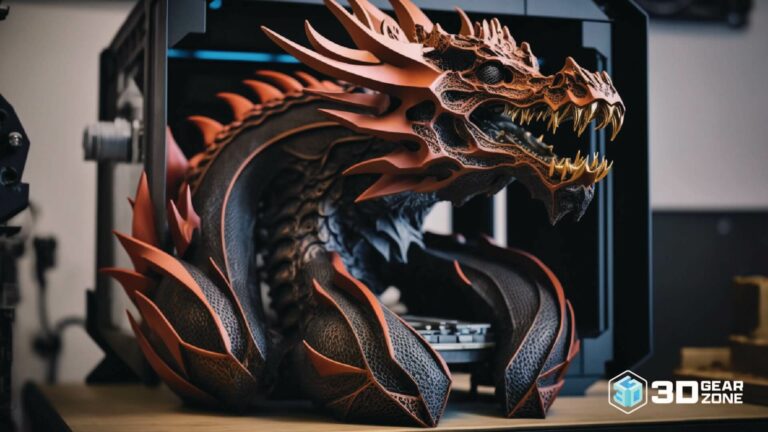Guide to 3D Printers
PLA vs. PLA+: What Are the Differences?

Scott Gabdullin
Updated on November 15, 2023


Updated on November 15, 2023

Share This Post
So, you’ve gotten into 3D printing and don’t understand the differences between PLA and PLA+? Not to worry, we’ve been there too! With so many acronyms in the 3D printing world, things can get complicated pretty quickly. We’re here to explain the differences and get you back to printing with the best plastic polymer for your needs.
3D printers commonly use PLA filaments for fused-deposition modeling (FDM) 3D printers. Both options are easy to use with home 3D printers and don’t create toxic fumes, making them safe for frequent use. That said, there are benefits to choosing PLA+ instead of standard PLA if your 3D-printed creations have load-bearing applications.
Continue reading to learn more about PLA vs. PLA+, why the two materials are different, and which one you should choose for your next 3D printing project.
PLA, polylactic acid, or polylactide, is a 3D printable filament that’s an alternative to acrylonitrile butadiene styrene (ABS) or polyethylene terephthalate glycol (PETG) filaments.
This plastic monomer is an eco-friendly alternative to other 3D printable filaments because it’s manufactured by fermenting sugar or starch from natural sources, like corn or cassava, instead of fossil fuels.
PLA is an affordable and readily available 3D printing material. Unfortunately, PLA is brittle, making it more likely to snap than some other more flexible 3D printing options. That’s why some manufacturers offer PLA+ with more flexibility, durability, and better tolerance for higher temperatures.
Depending on the manufacturer, PLA+ has many different names. For example, you might see terms like PLA Pro, PLA Plus, tough PLA, and more.
PLA+ is usually an upgraded formula of a company’s standard PLA filament. The upgrades could be additives and modifiers that enhance the user experience with their 3D-printed creations. Sometimes, PLA+ uses different ingredients than standard PLA. However, we’ve seen standard PLA marketed as PLA+ because the company uses advanced processing methods that help it perform better.
While the differences between PLA and PLA+ can be tricky to spot, below we’ll explain all the differences that set one 3D printing filament apart from the other and which option is best for your printing needs and wallet.
When choosing between PLA vs. PLA+, there are things to consider before purchasing. Ask yourself questions like: What will you use your 3D creation for? Will it have moving parts? Will it need to hold weight? Will you position it in direct sunlight?
Then, consider the significant differences between PLA and PLA+ and how they affect your answers to the above questions and other project needs. We’ve listed the most important ones below.
Marketing plays a major role in the confusion around the topic of PLA vs. PLA+. Marketing terms can make it challenging to understand the difference between a standard filament made from bio-sourced polylactic acid or a hybrid product with additives and modifiers.
Thus, our tip is simple: Stay away from companies that use vague terminology to describe their products.
Even if they use marketing jargon, you should finish reading the product description and feel informed about why the filament differs from a standard PLA filament.
The best way to spot the difference between the best PLA and PLA+ products is to read the fine print, product descriptions, and product FAQs. Customer reviews are also great for learning more about the product without confusing marketing terms.
Manufacturing companies are usually tight-lipped about their exact formulas for PLA+ 3D printing products. However, the major difference between PLA+ and PLA filaments is typically the ingredients.
Some companies add fillers, nucleating agents, other thermoplastics, and/or pigments to their standard PLA filaments. The reason for these additives is to increase the strength of the 3D print material. For example, PLA+ is less brittle than PLA. By modifying the ingredients of PLA, PLA+ becomes a more flexible option that has more bend before it breaks.
In general, PLA is also known to be an odorless material. And if ever users do smell something, it’s faint and has an odor that can be described as “sweet” like corn. PLA+’s smell might be a little stronger, but that’s only because of the extra heat it needs to be used.
Sometimes, the difference between a PLA+ and PLA 3D printing filament is the processing methods during production.
Earlier, we mentioned marketing terms being a factor in the confusion between PLA+ and PLA. Sometimes, companies market their PLA products as PLA+ when they’ve processed the products differently, even though they contain the same ingredients.
Different production methods can influence the product’s performance or make it more eco-friendly, making PLA+ a better option for those looking for an easier-to-use product. That said, additional steps in the production process usually result in higher prices for PLA+ filaments.
Both PLA and PLA+ need adhesion, like cyanoacrylate glue (Super Glue), to stick better to smooth surfaces. That said, PLA+ typically has better layer adhesion because it has a slightly higher printing temperature than PLA filaments. So, keep reading for more details about PLA and PLA+ printing temperatures.
PLA and PLA+ are comparable for those who want to print on a smooth surface. PLA+ is slightly better than PLA for uneven surfaces because the higher melting temperature enables it to get into surface grooves.
One of the best benefits of PLA+ vs. PLA is its additional flexibility. PLA+ typically has better resistance to pressure, meaning it slightly bends to withstand weight and pressure. In comparison, PLA is brittle and snaps more easily than PLA+ filament. People generally avoid it when they need to print prototypes or parts that need to carry some level of weight.
The added durability of PLA+ makes this 3D printing material an excellent option for those printing functional models with moving parts that bear loads. Why? Because if you’re creating a 3D printed device that moves, the pieces will need to be flexible enough to support changes in weight and pressure but durable enough to perform its functions.
PLA is strong enough to be a suitable printing filament for most jobs, but it’s worth it to spend extra on PLA+ if your 3D print isn’t merely aesthetic.
Both PLA+ and PLA offer good surface quality with a smooth finish, though PLA+ typically has better surface quality with less roughness and waves in your 3D printed creations.
PLA+ provides superior surface quality because it has a higher printing temperature range, giving a more uniform and smooth print.
Still, achieving a perfect, blemish-free surface straight from the 3D printer is near impossible, regardless if you used PLA or PLA+ products. Thus, you’ll likely have to sand or polish your 3D-printed creation. You can also improve the surface quality of your prints by dipping them into a resin or epoxy coating.
Printing temperatures for 3D printer filaments vary depending on the manufacturer. Still, overall, PLA filaments melt at lower temperature ranges than PLA+ filaments.
PLA filaments typically have a melting range between 190 to 220 degrees Celsius. PLA+ needs higher printing temperatures, ranging between 200 to 230 degrees Celsius.
A higher printing temperature means that layer adhesion and surface quality are better with PLA+ filaments than with PLA ones. It also means that your 3D printed creations with PLA+ can better withstand direct sunlight than PLA.
When it comes to ease of printing, PLA filaments are typically more user-friendly. Some people find that PLA+ filaments can be more challenging to use, though the ease of use will also depend on your creation and the brand you use to make it.
PLA+ filaments are harder to use because, in some cases, the higher temperature ranges or added technical properties make them more challenging to work with than standard PLA. For example, you might find the texture of PLA+ different from standard PLA, which takes time and practice to get used to.
We recommend trying PLA+ if you’re used to PLA, and vice-versa, to see how the change affects your printing experience.
PLA and PLA+ are readily available 3D printing materials, but standard PLA products are typically less expensive than PLA+.
The cost of PLA products ranges from manufacturer to manufacturer. Still, you’ll notice a price difference of around $5 to $15 more for PLA+ products compared to their standard line.
The lower cost of PLA vs. PLA+ makes PLA a better option for those who are creating affordable aesthetic pieces that don’t bear weight. Still, PLA+ is rightfully able to justify its slightly higher price point with its improved flexibility and durability, as we’ve discussed above.
There’s a huge variety of color choices with both PLA and PLA+ 3D printing materials. That said, standard PLA products usually have more color choices than PLA+ ones, if only because they’ve been around longer.
Still, PLA+ color choices are pretty varied, so it’s very likely that both options can provide you with the colors needed for your project.
If being eco-friendly is part of your printing checklist, then the environmental friendliness of your material may also be something you’re considering. PLA is typically made out of plant materials, such as sugar and cornstarch. However, PLA+ may contain additional additives that give it its enhancements.
But, as mentioned, some companies like to market their products as PLA+ because of a difference in processes. If you’re that worried, you can always check the material safety data sheet of your chosen PLA+ brand.
Both PLA and PLA+ tend to absorb moisture during storage. This can negatively affect the quality of your prints. Therefore, they always must be kept in a dry, cool place.
However, due to a slight difference in ingredients, PLA+ is able to better resist the conditions of your surrounding environment.
PLA+ has a lot of added benefits that make it an upgrade from PLA. That said, PLA+ is more costly.
If you need a filament for your 3D printer for aesthetic creations without moving parts, go with standard PLA. However, if you’re creating something with moving functions and load-bearing parts, PLA+ is worth the extra cost.
Sometimes, the difference between PLA+ and PLA is just marketing terms. However, high-quality PLA+ has additives and modifiers that help it to melt at a higher temperature range, giving superior surface quality and layer adhesion. PLA+ is also more flexible than PLA, giving it better pressure resistance so it can bend with pressure instead of snap with the weight.
Standard PLA is an affordable 3D printing material that’s readily available in a wider range of colors than PLA+. Users typically find PLA easier to work with than PLA+, though this is a matter of personal preference.
When choosing the right 3D printing filament, select one that works best for your project. If you want something durable, flexible, and more resistant to heat, choose PLA+. But if you prefer a 3D printing material that’s cost-effective and gets the job done well, go with standard PLA. Or, try both and decide which one suits you best.
3D printing is an amazing technology that allows anyone to 3D print amazing objects out of various materials, including PLA and PLA+.
While some 3D printers prefer PLA+ because it has better resistance to pressure and withstands higher temperatures, others enjoy using PLA because it’s more affordable, easy to use, and more readily available.
Still, if you need a 3D printed object that can withstand bending, falls, and high temperatures, PLA+ is your best option. But for everything else, PLA remains a practical and eco-friendly option.
Now that you know who wins in the battle between PLA vs. PLA+, you can choose which 3D printing filament is best for your next project.
Share Article

We are dedicated to delivering honest and objective reviews. Our mission is to help you select the right 3D products for your specific needs, budget, and interests.
Amazon.com Disclosure: As Amazon Associates, we earn from qualifying purchases.